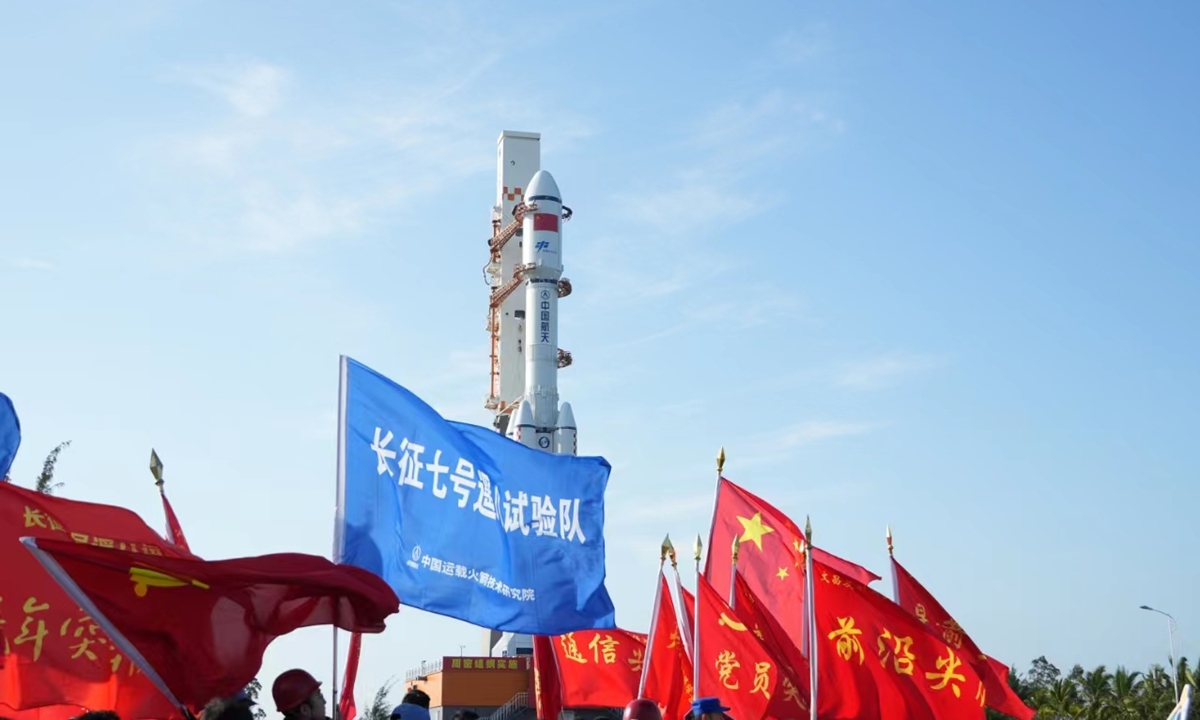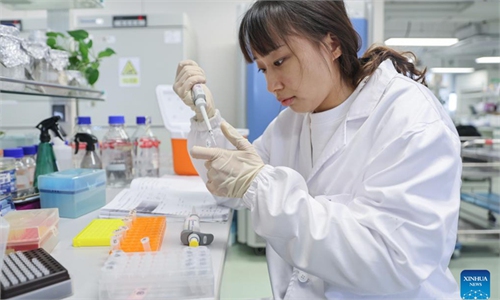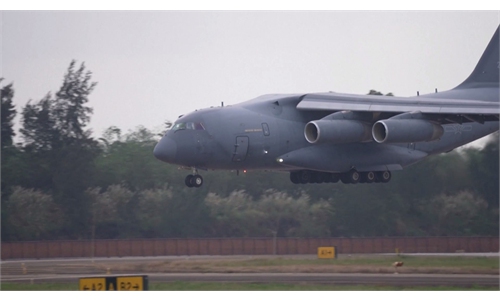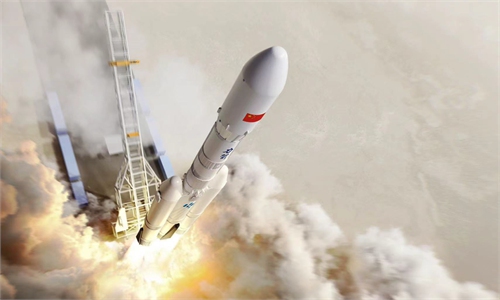
The combination of Tianzhou-7 cargo spacecraft and Long March-7 Y8 carrier rocket rolls out to the launch pad in Wenchang Space Launch Site in South China's Hainan Province on January 15, 2024. Photo: Gu Hangyu
The combination of Tianzhou-7 cargo spacecraft and Long March-7 Y8 carrier rocket was rolled out to the launchpad in Wenchang Space Launch Site in South China's Hainan Province on Monday. All facilities in the Wenchang spaceport are in good conditions and testing work is underway for the first China Space Station mission in 2024, the Global Times learned from the China Manned Space Agency (CMSA) on Monday.
Meanwhile, according to the Tiangong television, a vlog series documenting the life and work inside the China Space Station, seen on Monday, the current Shenzhou-17 crew members are now busy sorting the goods onboard and preparing for the incoming Tianzhou-7 cargo.
Tianzhou-7 will deliver about 90 kilograms of fruits, daily essentials for Shenzhou-17 and Shenzhou-18 taikonauts as well as supplies for environmental control and life support system to the China Space Station, state broadcaster China Central Television (CCTV) reported Monday.
The space station environmental control and life support system is functioning normally in orbit, with the oxygen recycling rate reaching 100 percent and that for water reaching 95 percent, Yin Rui, deputy commander-in-chief for the Chinese astronaut system, told the CCTV.
The latest episode of the Tiangong television also presented audience footages of the crew enjoying vegetables grown in space that has become a routine dish prepared by the crew.
The Shenzhou-17 crew members also decorated the Tianhe space station core module with traditional Chinese lanterns, adding festive atmosphere as Spring Festival, or the Chinese Lunar New Year, is also coming soon.
The previous Tianzhou-6 cargo spacecraft successfully departed the China Space Station combination and entered an independent flight stage on January 12, per the CMSA. The spacecraft is scheduled to reenter the atmosphere soon, where most of it will burn up, with remnants safely landing in a designated area in the South Pacific Ocean.
According to a previous official release, China will launch the Shenzhou-18 and Shenzhou-19 crewed missions to Tiangong in 2024, along with the two planned cargo runs. And the upcoming Tianzhou-7 will mark the first of the four launching missions to the Chinese permanent space outpost in 2024.
Since 2021, the Tianzhou cargo spacecraft has maintained a twice-a-year launch frequency. To meet the demands of frequent launches, the Tianzhou cargo spacecraft is produced in groups, the Global Times learned from mission insiders on Monday.
For instance, Tianzhou-3 to Tianzhou-5 were produced in one group, while Tianzhou-6 to Tianzhou-11 belong to this new group. This batch production method not only increases efficiency but also ensures that spacecraft in the same batch have similar appearances and functions.
The technical team has systematically upgraded the spacecraft in response to future mission requirements. For example, significant improvements have been made to the cargo bay of Tianzhou-6, greatly enhancing its cargo transport capacity. This means that the spacecraft can deliver more supplies to astronauts, supporting them for longer periods, per mission insiders.
And starting from Tianzhou-7, the frequency of the Tianzhou cargo delivery to the China Space Station will be reduced to three times every two years from twice a year, the CCTV said on Monday.
According to a Sunday report by the Xinhua News Agency, the "space potato seeds" that Shenzhou-16 taikonauts carried back to Earth, consisting of 20 combinations totaling 66,500 seeds, have been unboxed and handed over in Shangdu county, Ulanqab city, Inner Mongolia Autonomous Region.
These potato seeds, which traveled in space for over 180 days aboard the China Space Station, were returned to Earth and handed over by the China National Potato Engineering Research Center to the Shangdu Potato Technology Innovation Center for the next steps of experimental planting and subsequent evaluation and identification.
Zhang Linhai, director of the Shangdu Potato Technology Innovation Center, emphasized the growing importance of space breeding for generating new genetic resources.
The center will focus on sprouting, nurturing, and transplanting "space potato seeds," followed by continuous identification and selection of new varieties.
To expedite quality improvement and reduce the breeding cycle from over one decade to just a few years, the selection process will integrate the latest gene-editing technologies with traditional breeding methods, enabling precise modifications to the potato genome.




